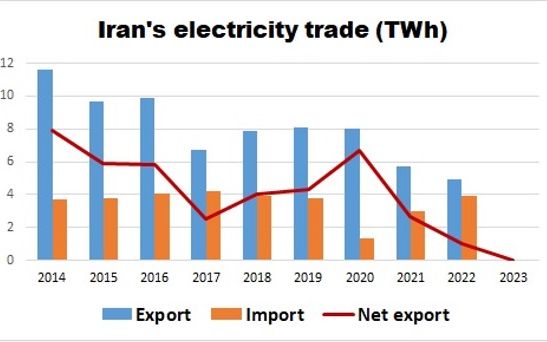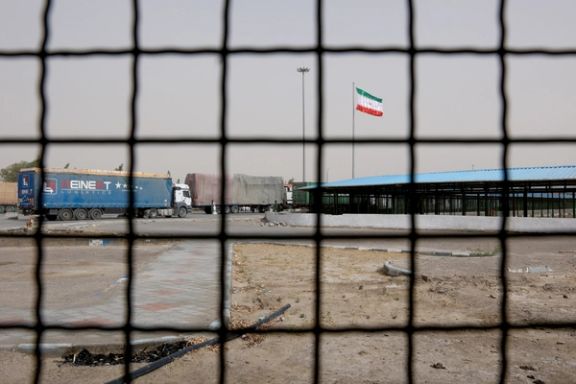Iran's Former VP Sentenced To 12 Months For Insulting Parliament Speaker

Iran’s former vice president under Hassan Rouhani, Es’haq Jahangiri, has been sentenced to 12 months' imprisonment for “false accusations against the parliament speaker.”

Iran’s former vice president under Hassan Rouhani, Es’haq Jahangiri, has been sentenced to 12 months' imprisonment for “false accusations against the parliament speaker.”
The court's recent verdict sentences Jahangiri to “four months of imprisonment for defamation and eight months for spreading falsehoods,” but considering Jahangiri's legal position, the prison term has been commuted to a cash fine of 440 million rials (less than 1$,000).
The sentence, based on a complaint filed by Parliament Speaker Mohammad Bagher Ghalibaf, is preliminary and subject to appeal.
Earlier this year, Mohammad Saeed Ahadian, the political and media assistant to the Parliament Speaker, referred to Ghalibaf's complaint against Jahangiri in a tweet, explaining that “Ghalibaf had filed a complaint in 2017 due to false statements made by Jahangiri.”
Simultaneously, media reports claimed that Ghalibaf's complaint against Jahangiri was related to the debates during the presidential elections in 2017. Mohammad Bagher Ghalibaf, one of the two main conservative candidates, targeted the Rouhani administration in his sharp attacks. The heated exchanges between Ghalibaf and Jahangiri led to intense debates.
Both Jahangiri and Ghalibaf withdrew in favor of their respective main faction candidates at the end of the debates. Ghalibaf supported Ebrahim Raisi, while Jahangiri cast his vote in favor of Hassan Rouhani.
The reopening of the old case by Ghalibaf is viewed by observers as an attempt to attract public attention on the eve of the upcoming parliamentary elections scheduled for the winter.

An Iranian official has acknowledged that the country’s net electricity export has reached zero, due to internal power deficit.
Official statistics indicate that during the last three years, Iran’s electricity exports were plunging gradually, while imports increased.
Mohammad Elahdad, the Deputy for Transmission and Foreign Trade at the Energy Ministry, said on November 15 that now the net electricity export decreased to zero.
This marks the first time in decades that Iran's electricity exports have equaled the country's imports. Iran imports electricity from Armenia, Azerbaijan, and Turkmenistan while exporting to Iraq. On Saturday, Arash Kordi, the managing director of Iran's electricity company Tavanir, claimed that the country is doubling the import of electricity from Turkmenistan.
Despite having net electricity exports of 8 terawatt-hours (TWh) a decade ago, this figure dropped to just over 1 TWh last year and has now reached zero.
The are reasons behind the decline in electricity exports. Domestic consumption increases at a high rate, because the government sells electricity at rock-bottom prices to consumers in a decades-old subsidy scheme. Inertia and fear of protests prevents the government from adjusting prices. Another major reason is the inefficiency of a government-controlled economy that breeds mismanagement and the expansion of the sector. Years of foreign sanctions have also played their role.
Over the past few years, Iran has struggled to meet its electricity generation growth targets, facing a shortfall of 14 megawatts (MW) during peak summer consumption.
Recent statistics from the Ministry of Energy indicate that only 20% of Iran's electricity generation growth targets were achieved in the first seven months of this fiscal year, that started March 22.
On the other hand, a big part of newly launched power plants has very low efficiency. If this trend continues, the country is likely to become a net electricity importer in the coming years.
The Ministry of Energy has recently omitted the monthly reports on Iran's electricity imports and exports, suggesting that the balance reaching zero is the reason behind this decision.

Iran, in exchange for importing electricity from Armenia, provides gas to this country (1 cubic meter of gas for every 3 kilowatts of electricity). However, for the imported electricity from Azerbaijan and Turkmenistan, Iran pays in currency.
The funds from Iran's electricity exports to Iraq are deposited into an account at the Trade Bank of Iraq in dinars. Due to Iran's limited imports from Iraq, approximately $10 billions of Iran's earnings from electricity and gas exports to Iraq over the past few years were effectively blocked in the Trade Bank of Iraq.
Until the middle of this year, Iran was only allowed to use these funds for importing non-sanctioned goods from Iraq, but the US government has issued sanctions waivers, allowing the Islamic Republic to transfer these funds to Oman in euros for importing non-sanctioned goods from third countries. It is still unclear how long Iran will continue its electricity exports, given the severity of the country's shortages.
For the current fiscal year (starting March 22), Iran had aimed to launch of over 5,000 megawatts of new power plants. However, in the first seven months (March-October), only 1,020 MW of power plants have been commissioned, with the majority being gas-powered plants with a modest efficiency of 30%. Iran has inaugurated only 33 MW of solar and wind power plants as well as 116 MW of relatively more efficient "combined cycle" power plants.
Although the country's power generation capacity is 92,000 MW, the operational capacity of the national grid is only around 71,000 MW. This means that approximately 23% of the country's power generation capacity is wasted due to aging and obsolescence.
Iranian authorities have repeatedly announced that the country faces a deficit of 14,000 MW during peak summer consumption.
Moreover, thermal power plants using mazut, diesel, and gas account for over 93% of Iran's total electricity generation. About three-quarters of Iran's thermal power plants are gas or steam-based, with a very low efficiency rate of around 30%. Iran had targeted converting these power plants to "combined-cycle" types with 45% efficiency for two decades ago but has not succeeded in this endeavor. The reasons include economic mismanagement and inefficiency coupled with various types of foreign sanctions.
Additionally, based on statistics from the Ministry of Energy and the Research Center of the Parliament, about 13% of the country's generated electricity is lost in the aged transmission and distribution network.
In comparison, Iran, only in the transmission and distribution network, loses as much electricity as half of the country's household consumption. The amount of electricity loss in the country's aged network is approximately 48 TWh annually.
Dr Umud Shokri, Energy Strategist and Senior Visiting Fellow at George Mason University
Dalga Khatinoglu, Azerbaijani expert on Iran’s energy issues

Amidst tightening hijab laws, numerous cafes and bookstores in Tehran, Mashhad, Tabriz, and a range of other cities in Iran have been closed.
In Alborz province, the police commander of Savojbolagh, Ali Soleimani, announced the closure of 9 out of 12 traditional cafes and restaurants visited during the implementation of the "Social Security Plan."
Simultaneously, in Semnan province, 23 shops were closed for "failure to observe Islamic norms."
In Esfahan province, police sealed two restaurants and four hair salons in the city for Falavarjan for “non-compliance with compulsory hijab” under the "Social Security Plan."
The wave of closures continues in Mashhad, where, in recent months, numerous cafes have been sealed for failure to observe compulsory hijab. On Tuesday, law enforcement commanders sealed Gorilla Café, a recently opened establishment. Meanwhile, Bakhtiari Café in Tabriz was sealed on November 11 by supervisory authorities for "failure to observe compulsory hijab."
A police official from Eslamshahr in the vicinity of Tehran revealed Saturday the closure of 121 shops and the confiscation of over 500 vehicles in the city due to non-compliance with compulsory hijab.
Hijab police have also been ramped up in Tehran metro stations.
The ongoing crackdown on women removing compulsory hijab, intensified after the death of Mahsa Amini during her detention by the morality police, has gained momentum.
The closure of commercial, business, and tourist facilities, hotels, administrative establishments, as well as internet companies, reflects the Iranian regime's inability to deal with women who defy hijab.

The Islamic Republic's government has warned travel agencies in Iran against marketing tours abroad featuring concerts by California-based Iranian pop singers.
The directive, issued by the General Directorate of Cultural Heritage, Tourism, and Handicrafts of Tehran Province, targets tours marketed by Iran-based agencies that include performances by diaspora singers that usually take place in neighboring countries. The action highlights a growing tension between the Iranian authorities and artists from the diaspora.
In the recent letter directed to travel and tourism agencies in Tehran, Parham Janfeshan, the director-general of cultural heritage, tourism in Tehran Province, expressed concerns about certain travel agencies advertising and selling tickets for concerts by certain singers, including those from Los Angeles. The communication underscored the importance of adherence to “Islamic values” and warns against potential violations.
The warning includes threats that the travel offices involved in the promotion and sale of services related to these concerts will be referred to a special committee for decision on possible penalties.
Hormatollah Rafiei, the head of the guild for Travel Service Offices and Tourism, warned against violations and emphasized that travel agencies operating permits exclude the right to promote these concerts.
Since the Revolution in 1979 -- when pop music was declared "haram" (forbidden) by the founder of the Islamic Republic Rouhollah Khomeini, Iranians have found ways to follow pop music they love. With domestic performances restricted to a very narrow type of regime-approved songs, a vibrant tradition emerged – Iranians began to travel to nearby countries to attend concerts by their favorite singers from the diaspora.

Primarily based in Los Angeles, these Iranian-American pop stars, barred from performing in their homeland, draw substantial crowds during tours in countries like Turkey, the UAE, Azerbaijan, Georgia, Armenia, and Erbil in Iraqi Kurdistan. These destinations are financially more affordable for Iranians, with fewer visa requirements.
The Los Angeles region is home to the world’s largest Iranian community outside of Iran and has been a scene of anti-Islamic Republic protest rallies especially since the start of the Women, Life, Freedom movement. There are about 400,000 Iranian-born immigrants in the United States and their children. More than a third of them live in the Los Angeles metropolitan region, according to data from the Migration Policy Institute.
Iranian pop stars enjoy significant popularity also among expatriates in European countries. Singer-songwriters Shahin Najafi and Mohsen Namjou are noteworthy artists based in Europe, boasting a sizable fan base of Iranian expatriates.

The popularity of foreign-based artists surpasses that of their Iran-based counterparts, forming a global community of Iranian music enthusiasts who overcome travel obstacles to enjoy performances prohibited in their country. To gauge their popularity, one can contrast Iranians spending an average of $200 per ticket for concerts by Iranian stars like Ebi, Dariush, or Googoosh in Turkey or Dubai with the popularity of international stars like Taylor Swift and Beyoncé. In Iran, concert tickets typically range from $5 to $10.
Warnings against going to such concerts were issued in previous years when these events were more regularly organized in neighboring countries. However, the recent campaign underscores an escalating divide, intensified by last year's Women, Life, Freedom protests. The nationwide revolt, sparked by the death in custody of 22-year-old woman Mahsa Amini, saw numerous exiled Iranian stars rallying behind the people and denouncing the regime's suppression of dissent.
The majority of these singers utilized their concerts as a platform to amplify the voices of Iranian protesters globally. Concerts by Iranian expatriates commonly featured images of iconic protesters harmed, detained, or killed by Iran's security forces, accompanied by chants against the Islamic Republic.
Iranian state-run media has consistently published reports criticizing the so-called Los Angeles singers, alleging that they take advantage of popular protests for personal gain. At the same time, the Islamic Republic detained renowned singer Mehdi Yarrahi after releasing a song in support of the opposition to the mandatory hijab, while Shervin Hajipour’s revolution song ‘Baraye’ was crowned the Best Song for Social Change at the Grammys 2023.

Afghan refugees are trafficked to Iran in a very coordinated manner and officials, from border police to authorities issuing legal documents might be involved, a recent report has revealed.
An investigative report published on Wednesday about the system behind the trafficking on Farazdaily, a news website in Tehran, featured interviews with people smugglers and refugees.
Currently, the Iranian government is being criticized for its seemingly lenient approach to Afghan refugees. Political opponents of the government have repeatedly warned of its "open borders" policy and possible hidden agendas. In response, the government has accused critics of inciting "Afghan-phobia" as a response to fast-growing anti-Afghan sentiment.
President Ebrahim Raisi’s administration is under scrutiny for allegedly trying to encourage the growth of the Afghan population in Iran, either to compensate for the decline of the native population, or to bolster its military by recruiting young Shiite Hazara Afghans immigrants. Iran has used thousands of Afghan fighters in the Syrian civil war to support strongman Bashar al-Assad.
Trafficking Afghans to Iran is a very secure and coordinated process, and there's little chance of getting caught, smugglers told Mostafa Kamali, the journalist behind the Farazdaily investigation.

This claim implies some involvement on the part of officials.
“Afghan smugglers are influential individuals who assure immigrants they will reach Iran safely and without any problems,” explains one trafficker.
“Sometimes it is possible to collude with others,” the smuggler adds, explaining that he pays soldiers manning the Afghan-Pakistan and the Pakistan-Iran borders and coordinates with them that at a certain hour, the cars will be crossing the border.
Also, he claims that some Afghans in Iran pay money to "some people" to get residency, without naming any organizations.
According to the report, the illegal migration “mafia” is also at least partially associated with the Afghan Taliban army and nobles.
In most cases, Afghans enter Iran through the Milak border crossing in the southeastern province of Sistan-Baluchistan, and they settle in Mashhad, Tehran, Shiraz and other cities where there are job opportunities, the smugglers explain.
Additionally, some businesses are interested in refugees and are willing to accept the cost of their being smuggled into the country.
"There are times when an Iranian asks for an Afghan laborer; when this happens, the immigrant does not have to pay any fees,” describes another smuggler.
However, the extent of the illegal immigration, which existed for the past four decades has reached new levels in the past two years. The smugglers refer to the system behind human trafficking as a “mafia”. “Can you imagine how many millions of Afghans live in Iran right now? A number like this cannot be accounted for by ten or twenty Afghan smugglers.”
Afghan immigration to Iran dates back to the early 1980s when they first arrived as refugees. As time progressed, they transitioned to becoming economic migrants.
Afghan refugees have been streaming through the border in recent years, with their total number now estimated to be between 6 to 7 million, according to the Iranian Parliament’s Research Center expert.
“After the Taliban's takeover of the Afghan government in 2021, we have definitely faced a flood of migration”, Mostafa Jahanbakhsh told IRNA state agency in October.
In the years prior to the Taliban's takeover, the total number of Afghans in Iran rarely exceeded two million.

Former Iranian Parliament Speaker Gholam Ali Haddad Adel, a figure close to Iran's ruler Ali Khamenei, has cautioned against Iran's participation in the Gaza war.
In a TV interview on Friday, the close relative of Supreme Leader Ali Khamenei stated that “Israel aims to transform the Gaza conflict into a war between Iran and the United States.”
The Expediency Council also warned that if such a scenario unfolds, the primary beneficiary of a secure existence would be the "Zionist regime”, the term used to refer to the Jewish state now at war with Iran-backed Hamas.
The proscribed terror group invaded Israel on October 7 and the US immediately backed the country’s right to defend itself in the wake of an attack which was the single most deadly day for Jews since the Holocaust.
His warning aligns with the recent sentiments expressed by former President Hassan Rouhani, who cautioned against Iran getting entangled in the Israel-Hamas conflict in Gaza. Rouhani highlighted the risk Iran faces due to its role in fueling the conflict and underscored the potential consequences of direct or indirect involvement, stating that “a wrong decision could draw the flames of war towards Iran.”
Former Foreign Minister Mohammad Javad Zarif also weighed in, stating that if Iran is dragged into the Israel-Gaza war, the consequences would fall on the people, not the state officials.
The conflict has resulted in the most severe escalation in the Gaza Strip since Hamas took control in 2007. Iran's proxies in Syria, Lebanon, Iraq, and Yemen have become involved, despite Tehran's continued denials of direct involvement.
The United States has strongly supported its ally Israel, mobilizing warships and troops in response to the attack. As a result, the alliance has also since led to US facilities in Syria and Iraq coming under fire from Iran's proxies in dozens of attacks.